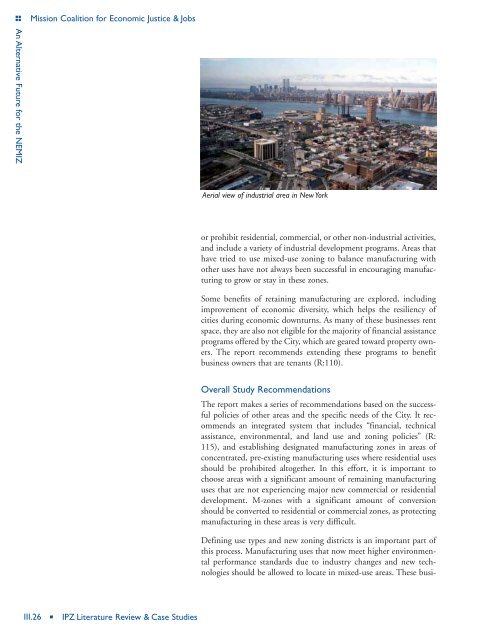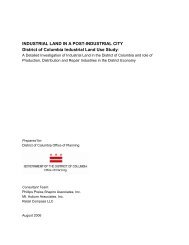An Alternative Future for the North East Mission Industrial Zone
An Alternative Future for the North East Mission Industrial Zone
An Alternative Future for the North East Mission Industrial Zone
You also want an ePaper? Increase the reach of your titles
YUMPU automatically turns print PDFs into web optimized ePapers that Google loves.
<strong>An</strong> <strong>Alternative</strong> <strong>Future</strong> <strong>for</strong> <strong>the</strong> NEMIZ<br />
<strong>Mission</strong> Coalition <strong>for</strong> Economic Justice & Jobs<br />
III.26 IPZ Literature Review & Case Studies<br />
Aerial view of industrial area in New York<br />
or prohibit residential, commercial, or o<strong>the</strong>r non-industrial activities,<br />
and include a variety of industrial development programs. Areas that<br />
have tried to use mixed-use zoning to balance manufacturing with<br />
o<strong>the</strong>r uses have not always been successful in encouraging manufacturing<br />
to grow or stay in <strong>the</strong>se zones.<br />
Some benefits of retaining manufacturing are explored, including<br />
improvement of economic diversity, which helps <strong>the</strong> resiliency of<br />
cities during economic downturns. As many of <strong>the</strong>se businesses rent<br />
space, <strong>the</strong>y are also not eligible <strong>for</strong> <strong>the</strong> majority of financial assistance<br />
programs offered by <strong>the</strong> City, which are geared toward property owners.<br />
The report recommends extending <strong>the</strong>se programs to benefit<br />
business owners that are tenants (R:110).<br />
Overall Study Recommendations<br />
The report makes a series of recommendations based on <strong>the</strong> successful<br />
policies of o<strong>the</strong>r areas and <strong>the</strong> specific needs of <strong>the</strong> City. It recommends<br />
an integrated system that includes “financial, technical<br />
assistance, environmental, and land use and zoning policies” (R:<br />
115), and establishing designated manufacturing zones in areas of<br />
concentrated, pre-existing manufacturing uses where residential uses<br />
should be prohibited altoge<strong>the</strong>r. In this ef<strong>for</strong>t, it is important to<br />
choose areas with a significant amount of remaining manufacturing<br />
uses that are not experiencing major new commercial or residential<br />
development. M-zones with a significant amount of conversion<br />
should be converted to residential or commercial zones, as protecting<br />
manufacturing in <strong>the</strong>se areas is very difficult.<br />
Defining use types and new zoning districts is an important part of<br />
this process. Manufacturing uses that now meet higher environmental<br />
per<strong>for</strong>mance standards due to industry changes and new technologies<br />
should be allowed to locate in mixed-use areas. These busi-












